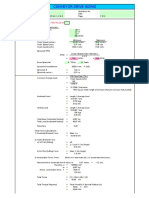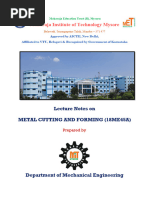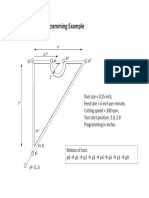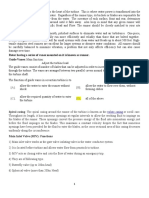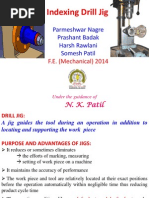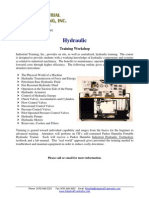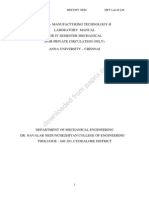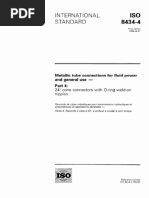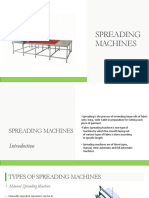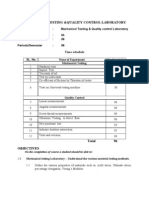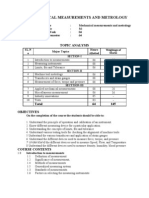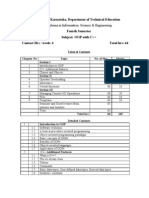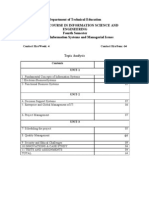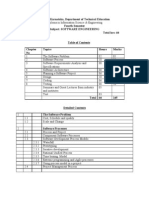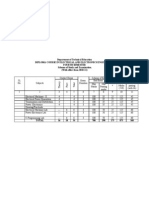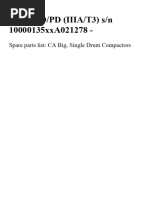Hydraulic & Pneumatic Controls
Hydraulic & Pneumatic Controls
Uploaded by
Vikram RaoCopyright:
Available Formats
Hydraulic & Pneumatic Controls
Hydraulic & Pneumatic Controls
Uploaded by
Vikram RaoOriginal Description:
Original Title
Copyright
Available Formats
Share this document
Did you find this document useful?
Is this content inappropriate?
Copyright:
Available Formats
Hydraulic & Pneumatic Controls
Hydraulic & Pneumatic Controls
Uploaded by
Vikram RaoCopyright:
Available Formats
Department of Technical Education Diploma Course in Automobile Engineering Fourth Semester Subject: HYDRAULIC & PNEUMATIC CONTROLS Contact
Hrs / Week:04 Contact hours / week : 64 TOPIC ANALYSIS SL. Hours Weightage Major Topics No Allotted of Marks SECTION - I 1 Introduction to Fluid Power Engineering 02 05 2 Fluid Power Fundamentals 03 05 3 Pumps 04 10 4 Valves 04 10 5 Actuators & accessories 06 15 SECTION - II 6 Pipes, Hoses and Fittings 04 10 7 Hydraulic Symbols and Design of circuits 08 25 8 Fundamentals of Pneumatics 02 03 9 Pneumatic Components 04 10 10 Pneumatic Symbols as per ISO1219 01 02 SECTION - III 11 Design of Pneumatic circuits 10 30 12 Combination circuits 04 15 13 Maintenance 02 05 14 Industry Institution Interaction 06 15 Tests 04 Total 64 145 GENERAL OBJECTIVES 1. Know what is fluid power 2. Know the importance of fluid power in automation 3. Understand the concepts behind hydraulic and pneumatic systems 4. Learn transmission of fluid power 5. Recognize and use components of hydraulic and pneumatic systems 6. Explain the construction and working of fluid system components 7. Build a circuit for hydraulic or pneumatic system 8. Apply the designed circuit to a real world scenario 9. Know the importance of fluid sensors and logic behind these circuits 10. Understand the schedule maintenance for fluid system.
COURSE CONTENTS 1. Introduction to Fluid Power Engineering 1.1 Fluid Power Engineering 1.2 general aspects 1.3 Role of Fluid Power Engineering in todays Industrial Automation 1.4 Elements of Automation and types 2. Fluid Power Fundamentals 2.1 Introduction 2.2 Methods of Transmission of power 2.4 Fluid Systems 3. Pumps 3.1 3.2 Pumps Classification of Pumps 3.2.1 Hydrodynamic - Centrifugal pumps, External Gear Pump, Lobe, Vane pumps - Axial pumps-piston-axial ,piston-inline, piston-radial pressure control valves-relief valve, balance valve pressure reducing valves directional control valve -poppet valve, spool valve, construction of 2,3 and 4 way dcv. Flow control valve - non-return/check valves -pilot operated sequence valve
4. Valves 4.1 4.2 4.3 4.4
5. Actuators 5.1 actuators 5.2 Linear actuators - Cylinders - single acting and double acting 5.3 Rotary actuators - Hydraulic Motor - Unidirectional - Bidirectional -Gear, vane, piston actuators
6. Accessory Components 6.1 Reservoirs 6.2 Accumulators weight loaded, spring loaded, gas loaded. 6.3 Intensifier 6.4 conductors/pipes; pipe fittings
7. Design of Hydraulic circuits - components - symbols - Hydraulic circuits - Basic hydraulic circuits - Meter in circuits - Meter out circuits - Bleed off circuits - Accumulator circuits - sequencing circuits - Regenerative circuits -pressure reducing circuits E.g.: Hydraulic circuit for brake, hoist, crane and jack circuits 8. Fundamentals of Pneumatics 8.1 Pneumatics 8.2 Applications of Pneumatics 8.3 Gas Laws, Pascal Law 9. Pneumatic Components 9.1 Air compressors 9.2 Types of air compressors - reciprocating piston compressor - Diaphragm compressor - Vane compressor 9.3 reservoirs/air receiver 9.4 FRL unit 9.5 valves - direction control valves 2/2, 3/2, 4/2 , 5/2 and 5/3 valve controls - manual - mechanical - pneumatic - electro pneumatic - combination of any 2 9.6 actuators 9.6.1 9.6.2 cylinders- single acting and double acting air motors- piston motor, gear motor, sliding vane motor
10
Pneumatic Symbols 10.1 Port markings 10.2 ports and positions 10.3 symbols as per ISO1219/ ANSI
11
Pneumatic circuits Hydraulic circuits and pneumatic circuits 11.1 Basic pneumatic circuit 11.2 control of double acting cylinder using 4/2 DCV 11.3 pilot controlled double acting cylinder 4/2 DCV 11.4 speed control circuit for a double acting cylinder 11.5 semi-automatic material handling circuit 11.6 time delay circuit combination circuits 12.1 advantages of combination 12.2 hydro pneumatic / pneumo hydraulic circuits 12.3 air over oil circuit 12.4 air over oil intensifier circuit 12.5 mechanical hydraulic servo system 12.6 electro hydraulic system 12.7 comparison of hydraulic, pneumatic and hydro pneumatic systems Fluidics/ Fluid Logics 13.1 Introduction 13.2 Advantage, disadvantage and application of fluidics 13.3 fluidic elements 13.4 classification of fluidic devices 13.5 fluid logic devices and types 13.6 Fluid Sensors and types of sensors Maintenance 14.1 maintenance of hydraulic system - common faults in hydraulic system - simple visual checks of oil - causes of contamination - preventive measures 14.2 common problems in pneumatic systems -maintenance schedule of pneumatic systems SPECIFIC INSTRUCTIONAL OBJECTIVES
12
13
14
1. Introduction to Fluid Power Engineering 1.1 Define Fluid Power Engineering 1.2 Brief about Historical perspective and general aspects 1.3 Explain Role of Fluid Power Engineering in todays Industrial Automation 1.4 Indicate the Elements of Automation and types 1.5 Clarify the Aims of automation 2. Fluid Power Fundamentals 2.1 Introduction 2.2 Discus Fluid Power
2.3 Explain Basic Methods of Transmission of power 2.4 Briefly describe Fluid Systems 3. Pumps 3.1 3.2 Define Pumps Classify Pumps 3.2.1 Hydrodynamic - Centrifugal pumps, External Gear Pump, Lobe, Vane pumps - Axial pumpspiston-axial piston-in-line piston-radial Sketch and explain pressure control valves-relief valve, balance valve explain pressure reducing valves Discuss the importance of directional control valve - what is control? - explain the construction of poppet valve, spool valve, construction of 2,3 and 4 way direction control valve. Flow control valve - Understand the significance of non-return/check valves - know the construction and working of Non return valve - sketch and explain pilot operated sequence valve
4. Valves 4.1 4.2 4.3
4.4
5. Actuators 5.1 Define actuators 5.2 Understand the linear actuators - Cylinders - Construction and working of cylinders - Construction and working of single acting and double acting 5.2 Know the importance of Rotary actuators - Hydraulic Motor - Unidirectional - Bi directional - explain the construction of - Gear, vane, piston actuators
6. Accessory Components 6.1 What are reservoirs? 6.2 Know the construction, working and uses of different accumulators Like weight loaded, spring loaded, gas loaded. 6.3 What is role played by Intensifier? - explain the construction, working and uses of an intensifier. 6.4 conductors/pipes; pipe fittings 7. Design of Hydraulic circuits - List of components - understand and use symbols
- Introduction to design of hydraulic circuits - Create basic hydraulic circuits - Meter in circuits - Meter out circuits - bleed off circuits - Accumulator circuits - sequencing circuits - Regenerative circuits -pressure reducing circuits E.g.: Hydraulic circuit for a Robot ARM 8. Fundamentals of Pneumatics 8.1 Define Pneumatics 8.2 Applications of Pneumatics 8.3 Gas Laws, Pascal Law 9. Pneumatic Components 9.1 Air compressors 9.2 Types of air compressors- reciprocating piston compressor - Diaphragm compressor - Vane compressor 9.3 reservoirs/air receiver 9.4 FRL unit- construction and working 9.5 valves - direction control valves 2/2, 3/2, 4/2 , 5/2 and 5/3 valve controls - manual - mechanical - pneumatic - electro pneumatic - combination of any 2 9.6 actuators 9.6.1 cylinders- single acting and double acting 9.6.2 air motors- piston motor, gear motor, sliding vane motor 10 Pneumatic Symbols 10.1 Port markings 10.2 ports and positions 10.3 symbols as per ISO1219/ ANSI 11 Pneumatic circuits Difference between Hydraulic circuits and pneumatic circuits 11.1 Basic pneumatic circuit 11.2 control of double acting cylinder using 4/2 DCV 11.3 pilot controlled double acting cylinder 4/2 DCV 11.4 speed control circuit for a double acting cylinder 11.5 semi-automatic material handling circuit 11.6 Time delay circuits e.g: Sorting of objects, punching operations, etc
12
Combination circuits 12.1 advantages of combination 12.2 hydropneumatic / pneumohydraulic circuits 12.3 air over oil circuit 12.4 air over oil intensifier circuit 12.5 mechanical hydraulic servo system 12.6 electro hydraulic system 12.7 comparison of hydraulic, pneumatic and hydro pneumatic systems Maintenance 13.1 maintenance of hydraulic system - common faults in hydraulic system - simple visual checks of oil - causes of contamination - preventive measures 13.2 common problems in pneumatic systems -maintenance schedule of pneumatic systems
13
REFERENCES 1. Hydraulic and Pneumatic ControlsAuthor: K.Shanmuga.Sundaram, Publisher: S. Chand 2. Oil Hydraulic and System Author: S.R.Majumdar Publisher: McGraw Hill 3. Pneumatic Systems Author: S.R.Majumdar Publisher: McGraw Hill 4. Pneumatic Controls Author: Joji P Publisher: Wiley India Ltd 5. Pneumatic Systems Author: Sirohi 6. Fluid Power with Applications
Author: Publisher:
Anthony Esposito McGraw Hill
7. Hydraulics & Pneumatics Author: Andrew Parr Publisher: Jaico Publishing house
Diploma Course in Automobile Engineering Fourth Semester Subject: HYDRAULIC & PNEUMATIC CONTROLS Model Question Paper Time :3 Hrs Max. Marks: 100 Note: 1.Section I is compulsory 2. Answer any six full questions from Section II, Section III, and Section IV Choosing at least two from each section SECTION -I 1 A) Fill in the blanks with appropriate words:1X5 I) The gear pump is ______________type of pump ii) A 4/3 valve consists of ____positions ____ports iii) According to Pascal law the pressure enclosed fluid is ____through out the practical system iv) The _______ valves are used to restrict the flow in one direction. v) In spool valve, the spools are moving _____within the valve body. B) Explain the basic logics used in fluid logics. 5 SECTION -II 2 a) State the importance of Fluid Power in Industrial Automation b) List the elements of automation c) State the Basic Methods of Transmission of power. 5 5 5
3 a) b) c)
Give the classification of pumps Sketch and explain external gear pump Explain briefly 4/3 direction control valve.
5 5 5
4 a) Define actuators 2 b) Explain with a neat sketch Construction and working of a double acting cylinder 8 c) Explain the working of unidirectional hydraulic motor 5 SECTION -III 5 a) What are Reservoirs? b) Explain the function of hydraulic accumulator-spring loaded with a neat sketch. c) Explain the working of an intensifier with a neat sketch . 6 a) Define pneumatics and mention applications of pneumatics. b) Sketch and explain reciprocating piston compressor c) Explain briefly sliding vane motor 7 a) Write brief note on ports and positions b) Explain the control of double acting cylinder using 4/2 DCV c) Sketch and explain Basic pneumatic circuit SECTION IV 8 a) b) c) 9 a) b) c) State the advantages of combination of circuits Compare Hydraulic and pneumatic systems Briefly explain electro hydraulic system State any 3 advantages and 3 disadvantage of Fluid Logic/Fluidics with an example, the implementation of AND logic Briefly explain-Reflex Sensors . . 2 7 6 5 6 4 4 6 5 5 5 5 6 5 4 5x3=15
10. Write short note on any three of the following a. b. c. d. e. common faults in hydraulic system causes of contamination Preventive measures. Maintenance schedule Common faults in pneumatic system -----------
You might also like
- Operations ManagementDocument290 pagesOperations Managementrockon60595% (113)
- SK140 SK480LC-8 Service Repairing ManualDocument292 pagesSK140 SK480LC-8 Service Repairing ManualPHÁT NGUYỄN THẾ98% (80)
- Lecture 2-3 Machine Tools Drive SystemsDocument86 pagesLecture 2-3 Machine Tools Drive SystemsSoad SolaimanNo ratings yet
- LIT2739 R9 PB308 Instruction ManualDocument16 pagesLIT2739 R9 PB308 Instruction Manualshirley bustos14No ratings yet
- Palm Oil Mill - FFB Conveyor Sizing BDocument4 pagesPalm Oil Mill - FFB Conveyor Sizing BAmin Buhari Md Zain100% (6)
- Recycling and Filament Extruder For 3D Printer PresentationDocument30 pagesRecycling and Filament Extruder For 3D Printer PresentationRJ Munn100% (1)
- Cryogenic Machining PresentationDocument27 pagesCryogenic Machining PresentationhemakumarsNo ratings yet
- Autodata 2018-03 PrehladDocument9 pagesAutodata 2018-03 PrehladNuty IonutNo ratings yet
- Drifter MontabertDocument8 pagesDrifter Montabertramoncalderon100% (2)
- Training Text SK125srlDocument276 pagesTraining Text SK125srlmuhammad irfan arasyidr100% (4)
- Motor Transmisie Volvo Ec140Document14 pagesMotor Transmisie Volvo Ec140Michael Davenport100% (1)
- Spirit AerosystemDocument5 pagesSpirit AerosystemIffeym IswanNo ratings yet
- Blocking FlowshopDocument13 pagesBlocking Flowshopimran_chaudhryNo ratings yet
- Whole Assembly of Motor BlowerDocument7 pagesWhole Assembly of Motor BloweryendiNo ratings yet
- Multi Class Coding SystemDocument20 pagesMulti Class Coding SystemDaniel LoretoNo ratings yet
- V BendingDocument4 pagesV BendingSufyan ZaighumNo ratings yet
- 4 PDFDocument316 pages4 PDFUmar IsmailNo ratings yet
- Machining Operations and Machine ToolsDocument18 pagesMachining Operations and Machine ToolsAnonymous mKdAfWifNo ratings yet
- AC & DC WindingDocument29 pagesAC & DC WindingSattar BalochNo ratings yet
- Scheduling 7 and SequencingDocument25 pagesScheduling 7 and SequencingBharadhwaj BalasubramaniamNo ratings yet
- Metal Cutting and FormingDocument228 pagesMetal Cutting and Forminggagansingh8144100% (1)
- Automatic LatheDocument20 pagesAutomatic LathedevalohithaaNo ratings yet
- Advanced Tool Design Question PaperDocument1 pageAdvanced Tool Design Question PaperMr. N. GnaneswaranNo ratings yet
- Design and Fabrication of Leaf JigDocument9 pagesDesign and Fabrication of Leaf JigAnonymous Clyy9NNo ratings yet
- CNC MachinesDocument35 pagesCNC Machinesfitriarp100% (1)
- Drill Jig Case StudyDocument16 pagesDrill Jig Case StudyVishal YadavNo ratings yet
- Screw Thread Measurement PART-1Document50 pagesScrew Thread Measurement PART-1chandrasekhar reddyNo ratings yet
- SSC Je PapersDocument28 pagesSSC Je PapersshubhamNo ratings yet
- Shop Floor PlanningDocument19 pagesShop Floor Planningdharm287No ratings yet
- Non Linear ProgrammingDocument7 pagesNon Linear ProgrammingmulyadiNo ratings yet
- CNC Manual Part ProgrammeDocument23 pagesCNC Manual Part ProgrammePradip PatelNo ratings yet
- NEA PrepationDocument21 pagesNEA Prepationaziz100% (1)
- Automatic Stirrup Bending MachineDocument19 pagesAutomatic Stirrup Bending MachineRishi MohanNo ratings yet
- Indexing Drill JigDocument7 pagesIndexing Drill JignkpatilNo ratings yet
- CAMDocument9 pagesCAMJay JoshiNo ratings yet
- Paper Processing Rotating Equipment Replacement PartsDocument4 pagesPaper Processing Rotating Equipment Replacement PartsDanielNo ratings yet
- Computer Aided Design and Computer Aided Manufacturing: Ashima WadhwaDocument15 pagesComputer Aided Design and Computer Aided Manufacturing: Ashima WadhwaGopikrishna KakaniNo ratings yet
- 2.9 Timer Functions 2.9.1 On-Delay Timer: Timer No K1TDocument9 pages2.9 Timer Functions 2.9.1 On-Delay Timer: Timer No K1TNisar AhmedNo ratings yet
- 6) Hacksaw Used in FittingDocument3 pages6) Hacksaw Used in FittingKrako TramNo ratings yet
- Information Service: Cylinder Reconditioning On Aluminium Cylinder BlocksDocument0 pagesInformation Service: Cylinder Reconditioning On Aluminium Cylinder BlocksMoaed KanbarNo ratings yet
- 1.unit 1 MechatronicsDocument63 pages1.unit 1 MechatronicsSolcastic SoulNo ratings yet
- Mechanics of Machines TutDocument11 pagesMechanics of Machines TutAnonymous TG3lME100% (1)
- Effect of Machining Parameters On Material Removal RateDocument9 pagesEffect of Machining Parameters On Material Removal RatesureshkumarNo ratings yet
- Designing Parts For Cold and Hot HeadingDocument93 pagesDesigning Parts For Cold and Hot HeadingSa RaNo ratings yet
- SREA-ECET (Mechanical) 8 Years Topic Wise Bit Bank-1 PDFDocument68 pagesSREA-ECET (Mechanical) 8 Years Topic Wise Bit Bank-1 PDFDhanunjay JaguNo ratings yet
- Sathyabama Question PaperDocument3 pagesSathyabama Question PaperamiestudentNo ratings yet
- Industrial Hydraulics TrainingDocument1 pageIndustrial Hydraulics TrainingDharma KusumahNo ratings yet
- Scotck Yoke PPT Veltech 2016Document29 pagesScotck Yoke PPT Veltech 2016Chockalingam Athilingam50% (2)
- Advanced Manufacturing Process: V.Ravisankar Prof. of Mfg. Engg. Annamalai UniversityDocument46 pagesAdvanced Manufacturing Process: V.Ravisankar Prof. of Mfg. Engg. Annamalai Universityravisankar varadharajaluNo ratings yet
- Telescopic Hydraulic Cylinder: Hydraulics PVT LTDDocument8 pagesTelescopic Hydraulic Cylinder: Hydraulics PVT LTDKedar PendharkarNo ratings yet
- c4 - Components in Hydraulic SystemDocument65 pagesc4 - Components in Hydraulic SystemBazil Suhaimi100% (1)
- Training ReportDocument34 pagesTraining ReportVarun AggarwalNo ratings yet
- ME8694 Hydraulics and Pneumatics SyllabusDocument2 pagesME8694 Hydraulics and Pneumatics SyllabusThangamKumarNo ratings yet
- Design CrimperDocument4 pagesDesign CrimperRomulus Situ MorankNo ratings yet
- Capstan & Turret LatheDocument18 pagesCapstan & Turret LatheNIKHIL CHIKATE50% (2)
- MFT2 Lab 2Document48 pagesMFT2 Lab 2dellibabu509No ratings yet
- Assignment of Thermal Engineering - 2 (3351901) PDFDocument40 pagesAssignment of Thermal Engineering - 2 (3351901) PDFNikhil Solanki100% (1)
- Iso 8434-4Document30 pagesIso 8434-4willian100% (1)
- Full Unit 1 NotesDocument65 pagesFull Unit 1 NotesRaagul SNo ratings yet
- Cutting MachineDocument64 pagesCutting MachineEruNo ratings yet
- Hydraulics and PneumaticsDocument6 pagesHydraulics and PneumaticslardominicNo ratings yet
- Fluid Power SystemsDocument142 pagesFluid Power SystemsAbel Aregay100% (1)
- IHP - Chapterwise Que Bank VBUDocument7 pagesIHP - Chapterwise Que Bank VBUshrnthbrdrNo ratings yet
- H & P SyllabusDocument3 pagesH & P SyllabusDrPrashant NeheNo ratings yet
- HVACR 10 Module 1 (FINAL)Document56 pagesHVACR 10 Module 1 (FINAL)Homer R. MagistradoNo ratings yet
- Mechatronics Lab ManualDocument54 pagesMechatronics Lab ManualAjay Chacko100% (1)
- PT18PCMTL5 - Applied Hydraulics & Pneumatics LabDocument37 pagesPT18PCMTL5 - Applied Hydraulics & Pneumatics LabvamshimohanNo ratings yet
- Value Engineering ArticleDocument89 pagesValue Engineering ArticleVikram Rao100% (1)
- 5.fluid Power LabDocument4 pages5.fluid Power LabVikram RaoNo ratings yet
- Mechanical Testing & Quality Control LabDocument4 pagesMechanical Testing & Quality Control LabVikram Rao100% (1)
- The Complete Sherlock HolmesDocument991 pagesThe Complete Sherlock HolmesVikram RaoNo ratings yet
- Design of Machine ElementsDocument53 pagesDesign of Machine ElementsSrks Kondal Reddy100% (2)
- 2.thermal EngineeringDocument7 pages2.thermal EngineeringVikram Rao100% (1)
- 4.mechanical Measurements and MetrologyDocument6 pages4.mechanical Measurements and MetrologyVikram Rao100% (1)
- 2.fluid Mechanics and MachinesDocument9 pages2.fluid Mechanics and MachinesVikram RaoNo ratings yet
- 7.machine Shop IDocument2 pages7.machine Shop IVikram RaoNo ratings yet
- Linux LabDocument4 pagesLinux LabVikram RaoNo ratings yet
- OOP With C++Document8 pagesOOP With C++Vikram RaoNo ratings yet
- Ada TheoryDocument10 pagesAda TheoryVikram RaoNo ratings yet
- EM & SOMDocument8 pagesEM & SOMVikram RaoNo ratings yet
- MISDocument15 pagesMISVikram RaoNo ratings yet
- Manufacturing Tech-1Document6 pagesManufacturing Tech-1Vikram Rao0% (1)
- Software EngineeringDocument8 pagesSoftware EngineeringVikram RaoNo ratings yet
- DBMSDocument8 pagesDBMSVikram RaoNo ratings yet
- Scheme 3rd & 4th SemDocument2 pagesScheme 3rd & 4th SemVikram RaoNo ratings yet
- Electrical Power GenerationDocument11 pagesElectrical Power GenerationVikram Rao0% (2)
- DBMS LabDocument2 pagesDBMS LabVikram RaoNo ratings yet
- Data Structures Using CDocument7 pagesData Structures Using CVikram Rao100% (1)
- Power Electronics LabDocument4 pagesPower Electronics LabVikram RaoNo ratings yet
- Scheme of StudyDocument1 pageScheme of StudyVikram RaoNo ratings yet
- Transmission and DistributionDocument10 pagesTransmission and DistributionVikram Rao100% (1)
- C - Programming LabDocument4 pagesC - Programming LabVikram RaoNo ratings yet
- Unigrout Flex M - Technical Specification - EnglishDocument8 pagesUnigrout Flex M - Technical Specification - EnglishEmrah MertyürekNo ratings yet
- Dynapac CA6000Document586 pagesDynapac CA6000Ruben FlorianiNo ratings yet
- Technical Particulars Doc 2119-2120-01 PDFDocument10 pagesTechnical Particulars Doc 2119-2120-01 PDFAnonymous YwlEXh5No ratings yet
- Catálogo de Cadenas SKFDocument20 pagesCatálogo de Cadenas SKFdeliaabreguNo ratings yet
- J-500 - 8999 4181 00 - Spare Parts Catalogue (en)Document1,663 pagesJ-500 - 8999 4181 00 - Spare Parts Catalogue (en)ulloapevoexNo ratings yet
- DOOSAN 430-440-450-460-470 PLUSDocument12 pagesDOOSAN 430-440-450-460-470 PLUSRafael Ribeiro (Landmachinery Lda)No ratings yet
- Hyd System - SMSC10 (SCP MC)Document45 pagesHyd System - SMSC10 (SCP MC)Prakash KumarNo ratings yet
- ред поворот PDFDocument20 pagesред поворот PDFrenatNo ratings yet
- BB8100 Line Boring Machine EDocument8 pagesBB8100 Line Boring Machine EJorge Ernesto Calderon LunaNo ratings yet
- Motoare Hidraulice-1 Cilindree-R8d-ItalgroupDocument210 pagesMotoare Hidraulice-1 Cilindree-R8d-ItalgroupANTON NEAGUNo ratings yet
- V S C Sec C Cte Ve Va: Pressure Control ValvesDocument13 pagesV S C Sec C Cte Ve Va: Pressure Control Valvesfrederick alayonNo ratings yet
- Patent Search Report 2Document32 pagesPatent Search Report 2akshayamani1998No ratings yet
- Hydraulics and PneumaticsDocument6 pagesHydraulics and PneumaticslardominicNo ratings yet
- Torque Hub Selection Guide 1210 PDF OrderDocument8 pagesTorque Hub Selection Guide 1210 PDF OrderGene KotlyarskyNo ratings yet
- Lab 01 The Application of Pressure Compensated VaneDocument15 pagesLab 01 The Application of Pressure Compensated Vaneafiqcivil980No ratings yet
- Describe The Differences Between The Following. Include Diagrams. A. Open Center Hydraulic CircuitDocument7 pagesDescribe The Differences Between The Following. Include Diagrams. A. Open Center Hydraulic CircuitMohammad UsmanNo ratings yet
- Basic Vocational: HydraulicDocument33 pagesBasic Vocational: HydraulicIbnu Awalla100% (1)
- Bw161ad 4Document8 pagesBw161ad 4Abdelrahman SharafNo ratings yet
- CraneDocument10 pagesCraneAkhmad SebehNo ratings yet
- ECR28 ECR38 BrochureDocument12 pagesECR28 ECR38 Brochuredalibor_bogdanNo ratings yet
- Oil Country TongsDocument79 pagesOil Country TongsKevin PaulNo ratings yet
- Catalogo Titan Hms 515Document2 pagesCatalogo Titan Hms 515Alexis SalazarNo ratings yet
- A New Concept of Rotary Hydraulic Motor Working With Alternating FlowsDocument4 pagesA New Concept of Rotary Hydraulic Motor Working With Alternating FlowsalokgobarNo ratings yet
- VP1 Service ParkerDocument16 pagesVP1 Service ParkerAdrian Alonso Bustos GonzalezNo ratings yet




